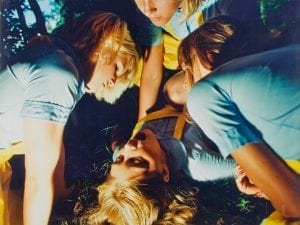A man with several ideas, Roberto Cuoghi has many personalities. His opening show at ICA in Autumn 2008 pushes the boundaries of sound, art and installation.
Ever since assuming his father’s identity in every walk of life for a seven-year period, Roberto Cuoghi has been pushing the boundaries for different mediums to be used in his art. Refusing to call this metamorphosis a performance, Cuoghi utilised his externalities, his everyday tasks, even his health, to recreate the daily life of his father with his very being as his canvas. He dyed his hair white, acquired a stoop, and wore special glasses to distort his vision. The focus of the piece was metamorphosis, he says, “metamorphosis seems a very democratic word because it allows changing mind,” and this theme has fascinated Cuoghi to the point of obsession.
Cuoghi’s assumption was informed by both fact and interpretation, but “everything serves the purposes of imagination, even wrong assumptions.” Fact and imagination further intertwine with materials and mediums throughout Coughi’s latest exhibition, Šuillakku, which debuted at the Museum of Contemporary Art in Rivoli-Turin, and is showing at the ICA in London from 14 October. The installation focuses primarily on sounds resulting from Cuoghi’s intense research into the final years of the Assyrian civilisation between 612 and 609 BC, and his own interpretation of the people’s reactions to the fatal assaults of the Medians and the Babylonians. Coughi’s improvisations pervade the vacant spaces of the ICA antechamber and main room, which is presided over by an isolated sculpture of the Assyrian deity Pazuzu. Segregated into four phases, Šuillakku represents isolation, anger, negotiation and despair respectively, and these emotions were lifted by Cuoghi from handbooks for assisting terminally-ill patients. Cuoghi comments, “they are the five stages for the psychological processing of the experience of death.” Notable by its absence, the fifth stage, acceptance, highlights in its omission, a human inability to consolidate ourselves with our lot: “I skipped the solution and everything remains suspended.”
Ironically, Cuoghi attests that “when you leave the ICA exhibition room, you will retain the memory of a space occupied by many people, aggressive, noisy and out of control, even though I have memories of the time during which I made my work as a time spent in complete solitude and extreme silence.” The isolation of Šuillakku’s creation is discordant with its representation in a public space, and he describes the sound selection as another form of contrast: “I decided calmly what I wished to keep and what I wanted to erase, moving and superimposing tiny sound fragments, considering the ensemble only when it takes shape.” The whole exhibition challenges the role of creator and strikes the listener as a work in progress, a collaboration between various peoples and civilisations, a “lamentation for the fall of Nineveh.”
The co-dependent interpretations of music and art have been inherently represented in Cuoghi’s use of self-reminders for his previous musical creation of a Zulu song, “in order to define the structure of the sound piece, I boiled down to make drawings to which I assigned musical meanings and somehow this worked out. Now, looking back at those papers, I don’t understand anything of what I wanted to do.” Cuoghi further explores hybridisation in aligning a physical recreation of various Assyrian instruments with the performances pre-recorded for the ICA space. Investing months of his research collating information about contemporary music forms, Cuoghi constructed reed flutes, harness bells, sistrums, trumpets and drums, all for use in his Šuillakku recordings. On concerns with authenticity and interpretation Cuoghi’s “main preoccupation was to record plausible sounds and to record them in the best way I could, using different microphones for different sounds”. On the one hand, Cuoghi’s reconstructions contradict plausible representations of the Assyrian civilisation through his use of twenty-first century technologies and a toy keyboard, but the authenticity lies in their organic, home-made constructions, with the exception of a large Sumeric lyre, Cuoghi employed a “do-it-yourself” attitude to the cacophony of sounds.
The current historical moment resonates with Cuoghi’s investigations of the fall of the Assyrians, “the first to conceive a unified world, a global state with one king, one language and one belief.” Cuoghi is clear to establish distinctions between Mesopotamia and modern Iraq, but asserts that “issues of the world are always the same. The real issue is how to interrupt this monotony: the increase of demand leads to the crisis of the resources that leads to war.”
The Šuillakku exhibition’s relevance is clear in an ever-more fragmented world of war and desperation because, “disgrace reinforces worship practices, multiplying superstitions.” The Assyrians are both idealised and taunted in their plight, “Assyrians were not an ethnic minority; they were the lions of the world. I describe them as close to their destiny, without any allies, abandoned to the paranoia.”
As a sound installation incorporating the artist’s instrumental creations, Šuillakku overlaps between many artistic forms and historical epochs. Transcending time and genres, Cuoghi’s focus on metamorphosis is ever-present because he is utilising modern facilities and a historical moment to express the universality of deifications in the face of adversity. When asked about the reactions displayed by visitors, Cuoghi cites “typical stimuli provoked by being surrounded by the pagan ceremony of a people abandoned by Gods. Forms of addresses and prayers screamed with rage, forced to share their space with animals, spits and weeping. I don’t know what kind of reactions may arise, but there’s nothing like that on MTV.”
Šuillakku was showing at the ICA from 14 October – 23 November 2008. www.ica.org.uk.
Pauline Bache




